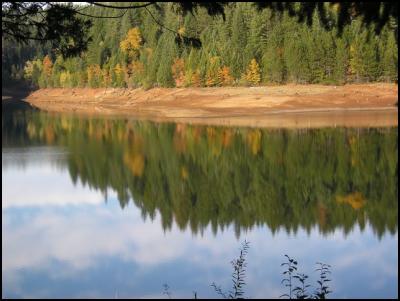The Sunny Edge of Winter
The Sunny Edge of Winter

Click to enlarge
The little creek that runs along the expanding edge of this northern California college town is flowing again after recent rains. I rode the bike out into the country, past signs proudly announcing new business and home sites. But it’s a beautiful day, and there are still unobstructed views of the fields, foothills, and canyon.
This place, where I often meditate when the stream is running (about seven months out of the year), was the most important prayer and ritual site for the local native peoples. Coyotes, rattlesnakes, and kestrels were still plentiful here when I first moved to town over a decade ago. But now, as the rainy season begins and the creek flows again, they are but a memory.
The great sycamore, which spreads its two huge trunks in a wide, U-shaped embrace as it reaches toward the sky, is slowly dying. But it’s good to hear the water dancing over the stones again, and to look out over the brown but soon to be green expanses of grassland toward the canyon.
Wealthy people from Los Angeles and the San Francisco Bay Area, who fled the malignant growth there only to bring it here, built massive homes at the mouth of the canyon in the last few years. One wonders what will it take to protect what is left of the earth.
Even as deciduous trees release their yellow, brown, and red foliage, new grasses and winter plants are bursting forth after the first serious storm of the season. The seasonal changes are subtle in northern California, and the dying and growing processes occur at the same time.
Nature is a mirror if one knows how to look. Watch the movement of the mind and emotions in the same way one watches the water flowing by, or the leaves drop in bunches from the trees in a gust of wind (that is, watch without judgment, evaluation, or analysis). One will find that the brain stops seeking security in the things of thought, and the mind falls as silent as a mountain lake on a windless day. Then one sees many things beyond words and images.
Meditation means effortlessly going from the conditioned state to the unconditioned state. Whether it lasts a moment or content-consciousness does not return at all, the ending of conditioning is the true meaning of freedom.
Recently, while driving back from the track as dusk was quickly turning into night, I was reminded how conditioning can be fatal.
In California, the law states that motorists must yield to pedestrians and cyclists in crosswalks at all times. Over the years, the unintended consequence has been to condition walkers and bikers to brazenly move into the intersection, because they know they have the right and expect vehicles to stop.
Most do. But being wrong just once in such a case will cost you serious injury or your life. Conditioning has led many people to forget that in a clash between a body and a car, the car always wins.
On this day I was turning left at a three-way corner at the heart of the college campus. Fortunately I wasn’t going very fast, because at the last moment I saw a girl on a bicycle. Her bike had no lights, and she had stopped directly in the path of the car.
We looked at each other for a couple of seconds. She had a glare that said ‘I’m in the right.’ I had a look that probably conveyed what I felt--‘what the hell?’ In that situation, it doesn’t matter who was right; what mattered is that I almost hit her, and she didn’t see the danger, even after the fact.
Though I resolved to be more careful, especially when driving near the campus, I saw that learning is not a function of conditioning, as the vast majority of people assume. It’s a function of un-conditioning the mind. And that is much harder to teach.
There is a principle in psychology called extinguishment, which means that a behavior or pattern is erased from the mind. But how does that occur?
Say one becomes aware of a habit. The usual reaction is to try to counter it, to act on it in some way to get rid of it. But if one dispassionately attends to oneself while performing the habit, and does so every time the habit comes up, the rut is erased, and the habit ends altogether. Experiment with it.
- Martin LeFevre is a contemplative, and non-academic religious and political philosopher. He has been publishing in North America, Latin America, Africa, and Europe (and now New Zealand) for 20 years. Email: martinlefevre@sbcglobal.net. The author welcomes comments.


 Eugene Doyle: Has WWIII Started?
Eugene Doyle: Has WWIII Started? Binoy Kampmark: Fencing The Ocean - Australia’s Social Media Safety Bill
Binoy Kampmark: Fencing The Ocean - Australia’s Social Media Safety Bill Binoy Kampmark: Trump, AUKUS And Australia’s Dim Servitors
Binoy Kampmark: Trump, AUKUS And Australia’s Dim Servitors Peter Dunne: Dunne's Weekly - The Wrong Answer To A Question That Does Not Exist
Peter Dunne: Dunne's Weekly - The Wrong Answer To A Question That Does Not Exist Martin LeFevre - Meditations: Perception, Conception And Beauty
Martin LeFevre - Meditations: Perception, Conception And Beauty Alastair Thompson: On The Publication Of The First NCQG Text 'New Collective Quantified Goal On Climate Finance'
Alastair Thompson: On The Publication Of The First NCQG Text 'New Collective Quantified Goal On Climate Finance'